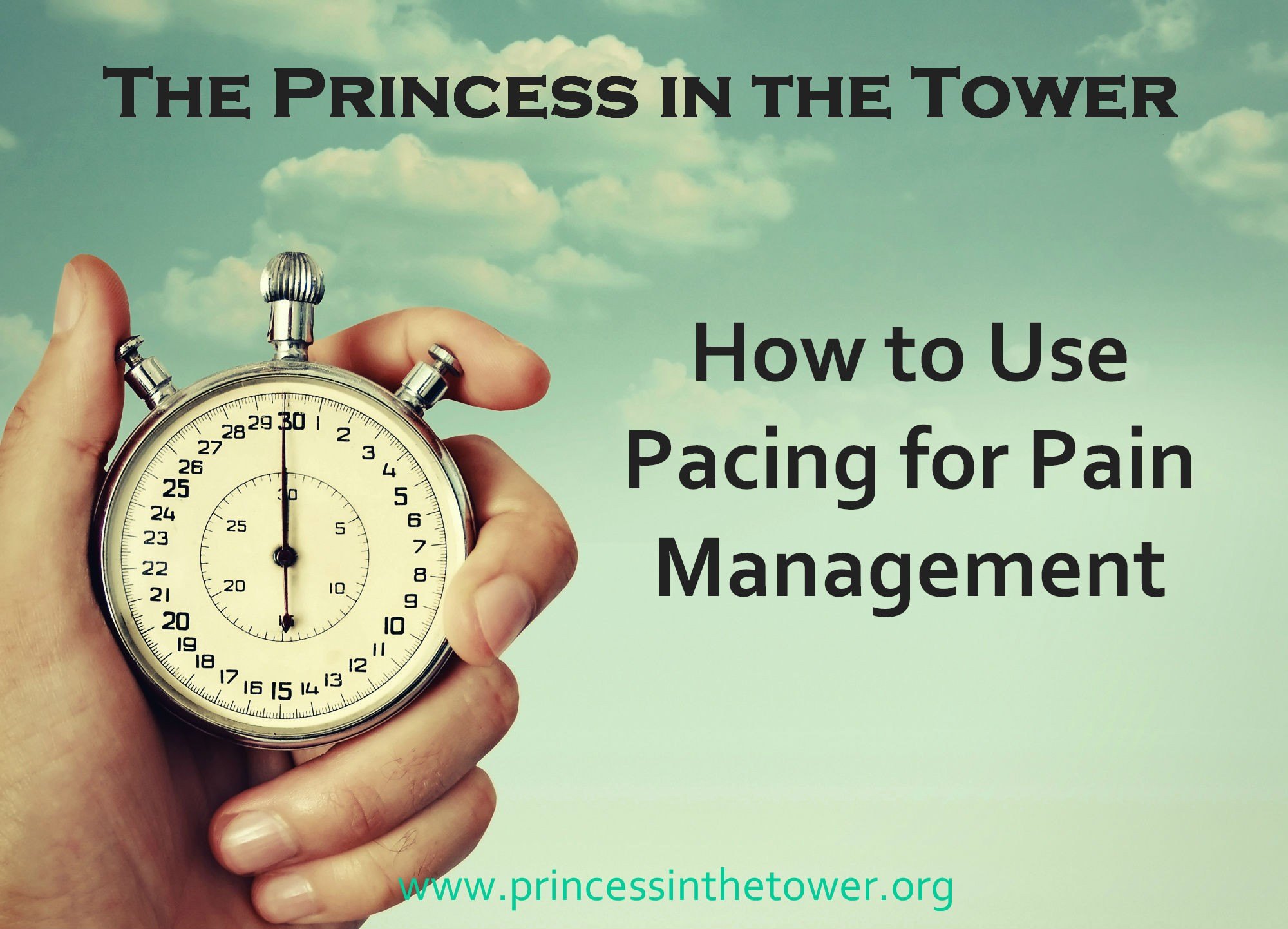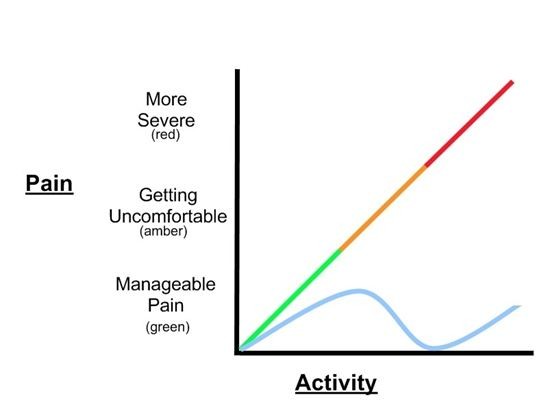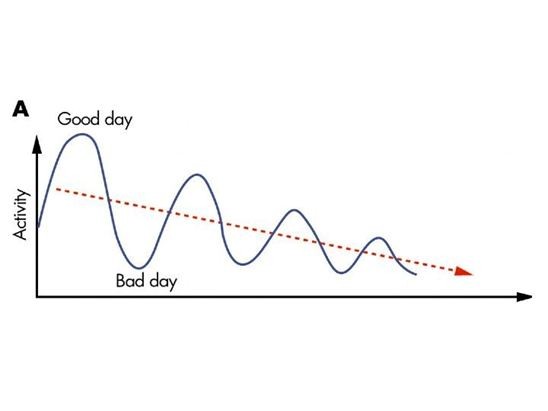Pacing to Manage Your Pain
The first rule of chronic pain management is pacing. Finding the exact amount of activity you can do without causing a flare-up of symptoms is almost an art form. The trick is to work out your time limits on activities such as sitting, standing, walking etc., and how long you can do each activity on a good day and how long you can do them on a bad day.
By limiting yourself to always stopping after the length of time you could do the activity on a bad day, you won’t push yourself to do more on a good day and consequently suffering for it the following day.
Pacing is a concept that pain specialists and pain psychologists instruct every client who is suffering from chronic pain. Many chronic pain sufferers are naturally far less active than they used to be and as a result, you may have noticed yourself trapped in a cycle of ‘boom and bust’ with activity and exercise (more details below).
An example of this is someone who wakes up one day and feel they are having a ‘good day’ and so decide to catch up on things while pain levels are manageable. Later that evening the symptoms are flared-up again, resulting in extended rest and ‘bad days’. Eventually it settles and the pattern is repeated again when they feel a bit better.
Another pacing problem is around those day to day chores that need to be done. These are the normal Jobs at work and home that build up around us. If there is a day when you feel better the the temptation is to try and do everything all at once because you don’t know when the next opportunity will be.
A third approach is the ‘never give in’ attitude. Refusing to let the pain beat you and stop you from doing what you want and need to do. This is when it feels you are at war with your pain and you are not going to let it win; the result is harmful on both a short and long-term basis.
With all these ways of approaching activity, it is followed by more pain and for some more inactivity follows as you try and settle it down – the ‘boom and bust’ cycle (see below). Your baseline level of fitness never really improves – if anything it gets worse.
Repeated flare ups of pain lead to more feelings of loss of control, anxiety and isolation as the cycle of chronic pain continues and even worsens. A pacing problem is basing your activity level on how you feel (doing more when you feel good and less when you feel bad).
Good pacing involves basing your activity level on pre-set, reasonable goals – not on your level of pain. To remedy a pacing problem, you will need a Pacing Plan that will help you to gradually increase how much you do of an activity, slowly and safely.
Avoiding Activity
It’s natural to avoid an activity, especially when you know it will make your pain worse. Forcing ourselves through the pain and trying to keep going for as long as we physically can is also a recipe for disaster. An example is when a pain patient is at home and finds it painful to sit up but then tries to do so on a rare meeting with friends only to pay severely for that later.
This may also mean that they are naturally very reluctant to try it again. They don’t want to spend their lives in bed, living with pain is bad enough without additional flares. Yet there is hope. Even extremely deconditioned bodies can be strengthened and your limits increased. Those who have lived with pain for many years can have an increasingly low activity threshold but do not despair, it can be increased but doing so slowly and using pacing is vital.
Baselines and Thresholds
Baselines and thresholds are judged by the length of time you can do an activity before your pain increases dramatically and cripples you. To begin, it may be as little as 30 seconds and then gently increased in micro amounts every week, never increasing by more than 30 seconds in a week. It can take a loooong time but I guarantee it is worth it.
It is vital to stop before the pain increases too much and becomes unmanageable and flares-up. This enables you to do more things and have a regular amount of activity each day instead of doing one or two things, being in too much pain to do anything more and being disappointed and in more pain, unable to do anything, possibly for the entire next day. Look at the example below:
Looking at the diagram below, the three categories have been labelled ‘manageable pain’, ‘getting uncomfortable’ and ‘more severe’. If you pursue an activity, without taking a break, your pain levels increase more and more. If you take breaks while the pain is manageable (indicated with the blue line) your pain levels stay manageable.
This also leaves room for unexpected activities or tasks, because your pain has not yet gone into the ‘getting uncomfortable’ category, your pain is still ‘manageable pain’. Using a stop-watch or timer with an alarm is a very useful tool to remind you to stop.
Have a look at the Spoon Theory link below as it’s a wonderful analogy to help you understand and manage your pain.
One difficulty experienced by many people with chronic pain is balancing activity and rest. Some people with chronic pain rest almost all the time. They started this when their pain was in the early stages thinking that rest would help. However they have become so out of shape that movement of any kind hurts – not just because of their chronic pain but because their muscles have become shortened and are tight and tense because they haven’t exercised.
Now that they no longer have the stamina to keep on at a task for even short periods of time. Again, this is most likely due to poor muscle strength and deconditioning on top of the chronic pain. If this sounds familiar, do not lose hope. You can claw back some of you mobility but it is vital to begin and continue very slowly and gently.
The flip side of those who rest too much are the people who force themselves until they get all their work done. They push on despite their pain at whatever cost and then they collapse in terrible pain at the end of the day. To get through the day, they may have taken extra pain medication, may have been irritable and not very pleasant to be around. They may accomplish their goal but it’s at great expense, sometimes even taking days or weeks to recover.
Recovery is slow and depressing. These people are in a vicious cycle of “feel better — push yourself — more pain — collapse”. This is where the “Boom Bust Cycle” applies. Take a look at the diagram below:
Using the diagram above, you can see how detrimental using your pain as a guide for your activity (and doing too much then having a flare-up of pain) actually is. Over time, you will be able to do less and less. This is why pacing is so important; it can even help you regain control and break the boom bust cycle.
A pacing problem is basing your activity level on how you feel (doing more when you feel good and less when you feel bad). Good pacing involves basing your activity level on pre-set, reasonable goals – not on your level of pain. To remedy a pacing problem, you will need a Pacing Plan that will help you to gradually increase how much you do of an activity, slowly and safely.
Maybe you need 5 minutes rest for every 15 minutes of activity, or an hour’s rest for 10 minutes of activity; the point is to find a reasonable ‘comfort’ level (if while in chronic pain there is such a thing!), while still being active every day possible.
Flare-ups can and do happen of their own accord (see Dealing with Flare-ups), but the technique of pacing massively limits the triggers that make so many flare-ups occur. Remember that setting a timer helps you remember rest periods as it is so easy to continue if you feel you can, thus exceeding your limitations and getting pain payback.
Your rest periods are a good time to practice relaxation techniques, sms a friend, listen to music, read a book or meditate. You may discover that you worked productively for a total of two hours, without increasing your pain ‘too much’, whereas, had you pushed yourself to work two hours straight, without a break, you would have increased the pain throughout the evening, night and possibly the next day (depending on your pacing levels), and finished a lot less work.
The idea of planning your activities and planning a rest break before your pain forces you to stop is a key technique of pacing and is sometimes called ‘working to schedule’ – this is in contrast to working to tolerance. When you work to tolerance, you push yourself to your limit.
Over time you will find your good days becoming a thing of the past as the ‘boom bust cycle’ repeats itself. This can be remedied by taking things very slowly and systematically planning activity and rest; by planning and sticking to it, you are in more control of your pain.
If you think it sounds complicated to create a Pacing Plan, Goalistics has created a custom Pacing Tool that will automatically create your plan for members. If you have a paid subscription to the Chronic Pain Management Program, you can use the Pacing Tool.
If you are not a subscribed member, do not worry, you can create your own pacing plan using this pacing chart: Click here to open the Pacing Chart
Using the chart, simply select your baseline in the first column. Look across the row associated with your baseline. The row will show you your starting point and weekly increases. Pacing is most effective if you do the activity at least 2-3 times per week, always keeping within your limits.
Sign-up and receive a free flare-up toolkit and regular posts and tips on living – and coping – with severe pain and chronic illness ♥
[avatar user=”jomalby” size=”thumbnail” link=”www.princessinthetower.org” target=”_blank”] Gentle hugs x[/avatar]



